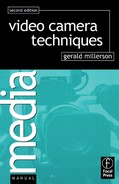There are really two ways in which you can organize shooting:
• Choose a camera position, then adjust the zoom lens’ focal length until you get the shot you want. But that is liable to result in haphazard mixtures of perspective (proportion and distance) in the course of a scene.
• Set the zoom lens to a ‘normal’ angle of around 20°–25°, then move the camera to a position where you have the right length of shot.
A normal lens angle gives few problems. The viewfinder’s perspective looks similar to that of the scene in front of you. The ‘feel’ of the camera seems natural – the way it handles, focuses, frames.
When shooting in small rooms though, a normal lens may not give you sufficient coverage. (You might try shooting through a doorway or window.) In cramped surroundings, it is often better to use a wider lens angle; although this will make the room seem larger. Where a foreground area looks empty and uninteresting on a normal lens, the effect can often be improved by reducing the lens angle.
Using a narrow-angle lens, a camera can be difficult to control smoothly. It is hard to avoid jerky movements, and to keep the subject accurately framed. Below about 5° a firm mounting is essential. It may even be necessary to lock the panning head to prevent camera shake or wind rock.
Because depth of field becomes shallower as the angle narrows (zooming in), accurate focusing becomes more difficult. The focus control may feel very coarse, so that even slight re-adjustments throw the entire subject out of focus. Subjects moving towards or away from the camera easily pass beyond the focused zone, particularly in closer shots.
Heat haze can produce an overall shimmering in close shots of distant subjects. The only solution is to move nearer. The characteristic depth-squashing that narrow-angle lenses produce on close-ups can only be overcome by widening the lens angle and moving closer.
Although popular for their greater depth of field and easy handling, wide-angle lenses cause subjects to appear too small and distant, and foreground space often looks excessive.
Close shots show considerable distortion, particularly on movements towards the camera. And because the camera is so near the subject, it is liable to cast shadows onto it, making lighting difficult. Wide-angle lenses are more susceptible to lens flares (especially in long shots), from any illumination pointing towards the camera (backlight).
Limited room
If the camera cannot move far enough away to get sufficient coverage on a normal-angle lens, widening the lens angle can help.
Varying framing
When following a moving subject with a narrow-angle (long-focus) lens, you are liable to produce an uneven weaving shot. Constant framing is extremely difficult.

